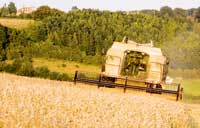Strong growth suits organic cereals

Varieties with a strong growing habit were showing their worth at the National Organic Cereals Event in Hampshire earlier this week. Louise Impey got a preview
The ability to cope with a big weed burden, produce good yields and avoid the main disease risks are all important characteristics in varieties destined for organic production systems, Roger Wyartt of Organic Seed Producers told Farmers Weekly ahead of the National Organic Cereals Event.
“The yield factor is important, as we’re looking for the best possible return. But we need to do that without risk, which is why a strong growing habit is important too.”
In addition, good grain protein was needed in milling wheats, as getting the required protein levels was still a major issue for organic growers, he said. “Fortunately we have got two milling varieties in our trials, Buzzer and Pireneo, which look promising.”
Of these two, Pireneo has a protein content some 1.5% higher than other milling wheats. “It has a spectacularly high grain protein, but that comes with a small yield penalty. It’s an awned variety, which may give it some drought resistance, and it’s taller than most.”
Buzzer, originally from Germany, had extremely good disease resistance, as well as a good protein content, he reported. “There’s a lot of interest from growers in the quality issues, as it’s an area which they struggle with.”
Disease resistance was of obvious interest in all potential varieties, but straw length was almost equally important, stressed Mr Wyartt. “The shorter varieties are no good for organic systems. If the blackgrass grows taller than the crop, then you have a problem.”
That was why candidate winter wheat Stigg, which had very good disease resistance ratings, including an eight for septoria, was unlikely to appeal widely, he explained.
National Organic Cereals National Organic Cereals 2010 was held at Fullerton Farms Partnership, Andover. The one-day event, organised by Organic Farmers & Growers, focuses on the challenges and rewards faced by farmers within the organic sector. |
|---|
“We’re trying it, because its disease profile is a breakthrough. But sites with any sort of a weed burden will be a challenge.”
The high yielding, short-strawed wheats preferred by conventional growers also yielded well in organic systems, he said. “But that’s only if they don’t get swamped by weeds. So we look for the taller types, which can deal with a weed population.”
Warrior and Scout are also in trials, although both are unlikely to have the required height to be competitive. In contrast, Lear, which performed well last year, was taller than others and competed well, he said.
“Claire is another variety which has done well in our trials, despite not being very tall, but Hereward failed to give the desired quality.”
The trials, which have been run for the last five years, feature both winter and spring cereal varieties and are conducted across five sites.
Drought stress was likely to affect the spring crops’ results this year, pointed out Mr Wyartt. “At this stage, they’re suffering far more than the winter-drilled varieties.”
While winter barley wasn’t of interest to organic growers, triticale definitely was, he continued. “It’s a crop which does well on less fertile sites and it has good disease resistance. Again, the taller varieties are the best.”
That means Grenado, which is otherwise a very good variety, is too short. “But Tremplin, Benetto and Agrano are all looking useful.”
Oats are suffering from being overdone. “There’s a hangover in the market – growers have got oats in the barn which they can’t sell. It’s a shame, as they too are good for organic production.”
Spring Cereals
Two spring barley varieties have passed the organic test, and there are a number of new choices coming through the system which look promising.
Dandy and Westminster were the main contenders, Mr Wyartt said. “Dandy is tall and lanky, and remains standing even in fertile situations. Westminster is also tall, but has a bulkier crop appearance.”
Having a high straw yield was a key characteristic, he noted. “The straw is almost as valuable as the grain.”
Quench was also grown as a preferred malting variety, he reported. “It is specified in some contracts.”
Spring wheat is an important crop, as quality is easier to achieve. “We’ve seen Paragon perform well – it’s tall and produces the right grain quality. Tybalt is higher yielding, while Amaretto is being put through its paces this year.”

